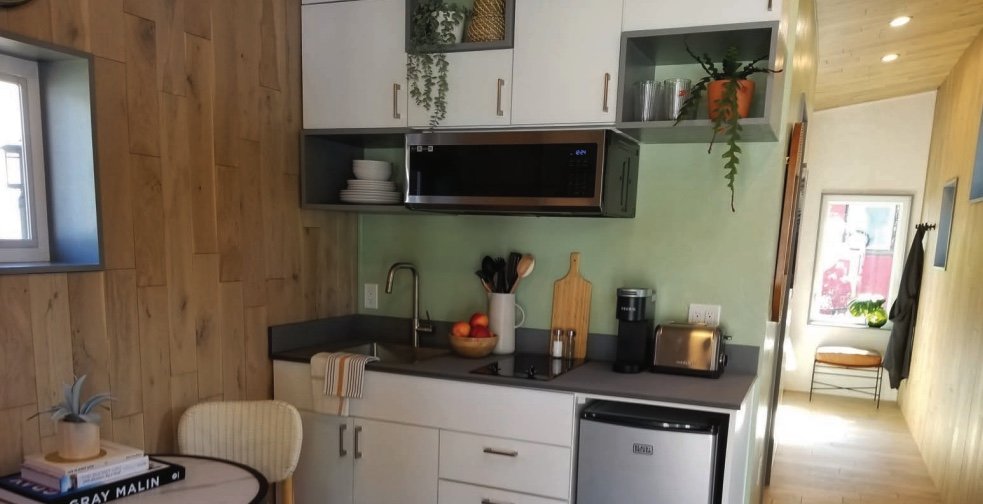Tiny-home village needs approval
The dining, kitchen area and hallway leading to the bedroom in a 250-square-foot model tiny home, on display at The Other Side Academy. Built and designed by University of Utah architecture students. Photo courtesy of The Otherside Academy.
A Salt Lake City Council vote on a proposed land lease and zoning change – needed to build a tiny home village on the west side of the city to serve Salt Lake City’s unhoused population – was postponed in September to allow additional feedback from nearby residents.
Public testimony on the project at a September 20 council meeting was mostly positive, but several residents voiced concerns, leading to Council District 2 Representative Alejandro Puy making a motion to postpone voting until further neighborhood testimony can be heard.
The tiny home community – named The Other Side Village – is a plan to house the chronically homeless in a sober living environment. Phase one of the project calls for approximately 50 homes of 250 to 400 square feet to be built on city-owned land located at 1850 W. Indiana Ave.
In order to accommodate the project, zoning must be changed from designated public land use (PL Zone) to form-based urban neighborhood use (FB-UN2). In addition, the project developers are requesting to lease 8 acres from the city for $1 for 40 years. For the lease to go through, the developers need to show that there will be a public benefit equal to the fair market value of the leased land.
The city is currently completing a public benefit analysis on the property. Samuel Grenny, Director of Communications for The Other Side Village, said the developers feel the criteria will be met since the site also calls for a park, performing arts center, amphitheater, grocery store, coffee shop, barbershop and hair salon, community garden, dog park, Airbnb facilities for visiting relatives, neighborhood gathering spots, mental and physical health facilities, and family services facilities.
When completed, the guarded and gated community is expected to contain up to 450 tiny homes for the chronically homeless, and will serve residents with peer counseling and surrounding support services, said Grenny, noting that residents will also be required to work at designated onsite jobs, including maintenance services a proposed cookie factory. At the September public hearing, Turner Bitton, chair of the Glendale Neighborhood Council, voiced his support of the project saying, “the homeless are counting on us to advocate for them,” and that the proposed amenities at the site will be a welcome inclusion to the neighborhood.
Opponents of the project said that lawmakers should look at other areas of the city, citing concerns of the growing unhoused population on the Westside’s North Temple area and noting that the Westside already hosts the majority of homeless-related shelters and services. In addition, residents raised concerns on how well the untested Other Side Village can run such a community, speculating that such a community could simply concentrate issues like crime and substance abuse.
Ester Stowell, chair of the Poplar Grove Council, echoed these concerns, saying she feels the project and its homeless population will increase drug use and violence in the surrounding neighborhoods and that the project, “is not a good thing for my neighborhood or my children.”
The developers have outlined various procedures and policies (to be part of the city agreement) that they feel will mitigate many issues that may arise from a concentrated homeless population.
Acknowledging those potential risks, Grenny said The Other Side Village wants to be “held accountable,” adding that his company will not solve all the homeless problems but will give hundreds of people the chance to get off the streets. A recent survey of 842 registered voters in the Glendale neighborhood indicated that 59 percent of those contacted expressed support for the village location, 30 percent were undecided, and 11 percent were opposed, Grenny said. The survey was conducted by Landslide Political. Meanwhile, a 250-square-foot model tiny home has been designed and built by students through a partnership with The Other Side Village, the University of Utah’s School of Architecture, Design + Build Salt Lake, and Denton House Interiors. The model tiny home is currently on display at The Other Side Academy.
The tiny-home village project got underway last April when SLC Mayor Erin Mendenhall asked The Other Side Academy (because of its proven track record of dealing successfully with marginal populations) to investigate a tiny-home village as one part of a solution to the city’s shortage of low-income housing.
According to the information in the village’s zoning amendment request, the housing will be arranged in neighborhoods of approximately 25-35 furnished homes, each with amenities and green spaces to include a small pavilion, laundry, and a multipurpose room for social gatherings. Most of the funding for phase one has been raised through private donations, and the Utah Homeless Council recently voted to give the village $4 million in public funds. The Other Side Village has nonprofit status and is founded on the conviction that housing alone will never solve homelessness, but community will, according to Grenny. The model relies on the combination of high-quality permanent housing and a strong culture of personal growth, support, connection, and peer leadership, he said, adding that the culture of the village is meant to help residents succeed in maintaining a dignified and self-reliant life. Villagers will pay an affordable rent and will be offered a variety of employment options through onsite enterprises. For more information on the village project go to theothersidevillage.com.

